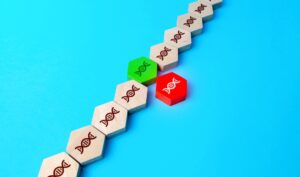Adrenoleukodystrophy (ALD)
What is ALD?
Adrenoleukodystrophy (ALD) is a rare genetic disorder that causes damage to the protective membrane around the nerve cells of the brain known as the myelin sheath. Individuals with ALD cannot break down certain very long chain fatty acids (VLCFA) causing a buildup in the brain’s nervous system and adrenal gland. It is estimated that ALD occurs in 1 in 18,000 births and mainly affects boys. Generally, the most serious form of ALD shows up in children between the ages of four and ten.
What are the symptoms of ALD?
The symptoms of ALD vary by the form of the disease present. Types of ALD include childhood cerebral demyelinating ALD, adrenomyeloneuropathy (AMN), Addison’s disease (hypoadrenocorticism), and female ALD. Symptoms per form include:
Childhood cerebral demyelinating ALD (most common form):
- Normal early childhood development with symptom onset between 4 and 10 years of age
- Attention defect disorder
- Addison’s disease
- Progressive intellectual decline
- Increasingly aggressive behavior
- Vision loss
- Crossed eyes
- Hearing loss
- Loss of muscle control
- Progressive dementia
- Permanent disability
- Muscle spasms
- Seizures
- Trouble swallowing
Unfortunately, these symptoms ultimately culminate to death at around 2 to 5 years after diagnosis.
Adrenomyeloneuropathy (AMN):
- Estimated symptom onset between 21 to 35 years of age
- Progressive motor stiffness and weakness
- Addison’s disease
- Paralysis of lower extremities
- Loss of body movement control ( ataxia)
- Development of vegetative state and death 5 years or longer after diagnosis.
Addison’s disease (only symptom in approximately 10% of individuals with ALD/AMN):
- Fatigue
- Weight loss
- Decrease appetite
- Low blood sugar
- Darker areas of skin color (pigmentation)
- Abdominal pain
- Sexual dysfunction and development delays
- Vomiting
- Weak muscles
- Coma
Female ALD (least common):
- Rarest form of ALD with symptom onset after the age of 35
- Progressive stiffness and weakness in lower legs with possible paralysis
- Joint pain
- Urinary problems
- Numbness
- Absence of Addison’s disease
What causes ALD?
ALD is caused by an inherited defect in a gene known as ABCD 1. This gene is located on the X chromosome. The defect causes the buildup very long chain fatty acids (VLCFA) in the brain. This accumulation causes the destruction of the protective covering surrounding nerves known as the myelin sheath and can harm the outer layer of cells in the spinal cord, brain, adrenal glands, and testes. Women are mainly found to be carriers of this disease as they have two X chromosomes and the remaining unaffected chromosome usually protects them from disease development. Females have a 25% chance of having a daughter that is a carrier and a 25% chance of having a son with ALD. Fathers cannot pass ALD.
Are there treatment options for ALD?
Much of the treatment of ALD is supportive and directed at symptom management and safety. The adrenal insufficiency, Addison’s disease, can be successfully managed with corticosteroids. Supportive treatment options include:
- Physical therapy
- Psychological treatment
- Special education programs
- Urology care
- Family counselors
- Dietary management
Other treatments are currently being studied and include:
Lorenzo’s oil was developed by parents of a child with ALD in 1982. This treatment is still being studied and is not yet FDA approved. Lorenzo’s oil is a combination of specific fats extracted from oil and rapeseed oil. The administration of Lorenzo’s oil has shown some promise in decreasing VLCFA however, must be given before the onset of symptoms and does not relieve symptoms present.
Stem cell transplants are also currently being studied. Though there has been some success seen there are some additional risks associated with this treatment including rapid advancement of disease.
A small molecule, NV1205, is projected to be in the clinic before the end of 2017 for treating X-linked ALD. This treatment works in reducing levels of very long chain fatty acids (VLCFAs) in these patients. $14 million has been put towards NeuroVia for the development of this treatment. Presumably, NV1205 will be a more effective treatment compared to the limited treatments currently available (ex. Lorenzo’s Oil and stem cell transplantation).
Where can I find more information on ALD?
Adrenoleukodystrophy (ALD) Articles

Hull Man Takes on 100-Mile Cycling Challenge for Rare Disease Awareness

Gene Therapy Promising for Cerebral Adrenoleukodystrophy but Carries Risk of Blood Cancer

ICYMI: Neuraxpharm and Minoryx’s Special Information Film Raises Leukodystrophy Awareness

ALD and MLD to be Screened in Newborns in UK Generation Study

Adrenoleukodystrophy Patient Receives Letter of Support from Royalty


Boy Living with Adrenoleukodystrophy Receives a Surprise Gift
-300x300.jpg)



